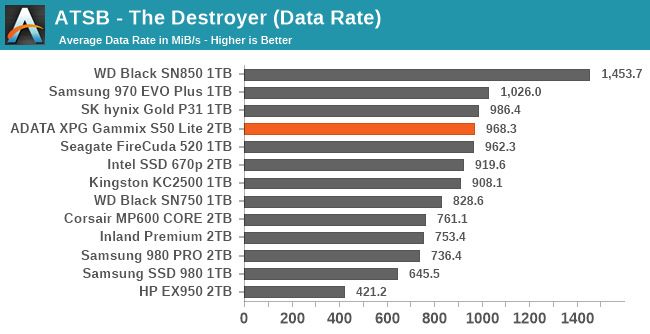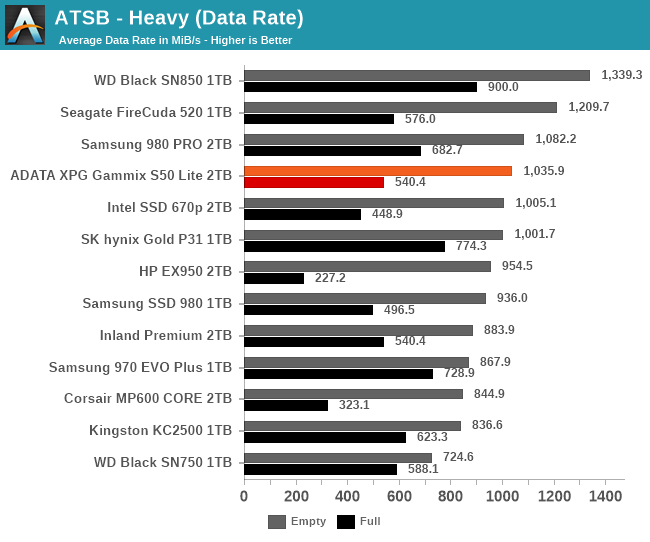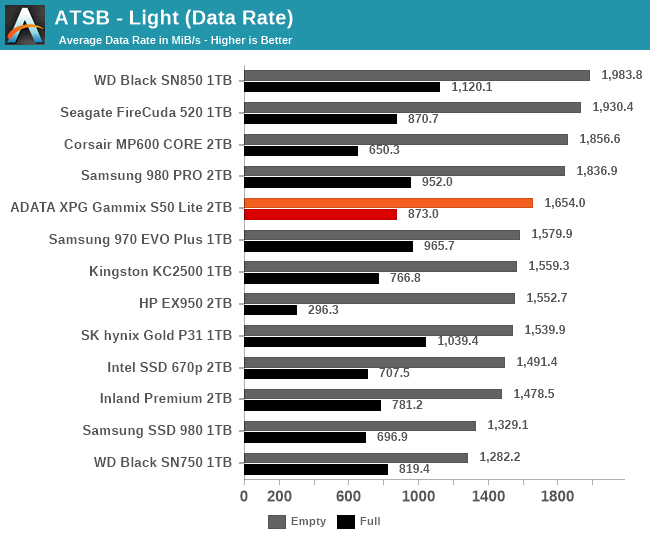The ADATA GAMMIX S50 Lite 2TB SSD Review: Mainstream PCIe Gen4
by Billy Tallis on April 30, 2021 8:00 AM ESTAnandTech Storage Bench - The Destroyer
Our AnandTech Storage Bench tests are traces (recordings) of real-world IO patterns that are replayed onto the drives under test. The Destroyer is the longest and most difficult phase of our consumer SSD test suite. For more details, please see the overview of our 2021 Consumer SSD Benchmark Suite.
 |
|||||||||
| Average Data Rate | |||||||||
| Average Latency | Average Read Latency | Average Write Latency | |||||||
| 99th Percentile Latency | 99th Percentile Read Latency | 99th Percentile Write Latency | |||||||
| Energy Usage | |||||||||
On The Destroyer, ADATA's S50 Lite offers similar overall performance to good PCIe Gen3 drives and the early Gen4 drives based on the Phison E16 controller. The power consumption is also similar to the Phison E16 drives, which is a bit disappointing since the S50 Lite's SM2267 controller is just a four-channel design, which should save a bit of power.
AnandTech Storage Bench - Heavy
The ATSB Heavy test is much shorter overall than The Destroyer, but is still fairly write-intensive. We run this test twice: first on a mostly-empty drive, and again on a completely full drive to show the worst-case performance.
 |
|||||||||
| Average Data Rate | |||||||||
| Average Latency | Average Read Latency | Average Write Latency | |||||||
| 99th Percentile Latency | 99th Percentile Read Latency | 99th Percentile Write Latency | |||||||
| Energy Usage | |||||||||
As with The Destroyer, we see the S50 Lite's performance on the Heavy test falling in the same general range as the top PCIe Gen3 drives, and it is clearly slower than top of the line Gen4 drives. The S50 Lite also has somewhat disappointing performance on the full-drive test runs, with higher write latencies than we'd like to see from a TLC drive. Power efficiency continues to be poor, though it is within the normal range for high-performance drives.
AnandTech Storage Bench - Light
The ATSB Light test represents ordinary everyday usage that doesn't put much strain on a SSD. Low queue depths, short bursts of IO and a short overall test duration mean this should be easy for any SSD. But running it a second time on a full drive shows how even storage-light workloads can be affected by SSD performance degradation.
 |
|||||||||
| Average Data Rate | |||||||||
| Average Latency | Average Read Latency | Average Write Latency | |||||||
| 99th Percentile Latency | 99th Percentile Read Latency | 99th Percentile Write Latency | |||||||
| Energy Usage | |||||||||
On the Light test, the S50 Lite appropriately does well, with slightly better overall performance than any of the PCIe Gen3 drives, and decent full-drive performance with no concerning latency scores.
PCMark 10 Storage Benchmarks
The PCMark 10 Storage benchmarks are IO trace based tests similar to our own ATSB tests. For more details, please see the overview of our 2021 Consumer SSD Benchmark Suite.
 |
|||||||||
| Full System Drive | Overall Score | Average Bandwidth | Average Latency | ||||||
| Quick System Drive | Overall Score | Average Bandwidth | Average Latency | ||||||
| Data Drive | Overall Score | Average Bandwidth | Average Latency | ||||||
The ADATA S50 Lite underperforms on all three of the PCMark 10 Storage tests. The most important comparison here is probably the Intel 670p, which uses basically the same controller and theoretically inferior QLC NAND. But the 670p's firmware is tuned so that it gets the most benefit out of its SLC cache on all three of these tests, which clearly isn't happening for the S50 Lite.










93 Comments
View All Comments
yannigr2 - Friday, April 30, 2021 - link
Years are passing by and the cost per GB is moving up instead of down.deil - Friday, April 30, 2021 - link
but speeds go up a lot. if you compare those to 60GB ssd's of 2005'ish those are 100x fasterStrangerGuy - Sunday, May 2, 2021 - link
Obviously he implies recent price trends in a market where some older products are clearly better then new ones not only in performance/$ but also in absolute performance.But sure please keep up your disingenuous trollish comparisons. Maybe you would also want to elaborate how current GPUs aren't overpriced because they are a million times faster than the 1998 TNT?
TheinsanegamerN - Thursday, May 6, 2021 - link
Take a chill pill dude. You still get way more bang for your buck on sSDs now then you did 3-4 years ago. 4-8TB m.2 drives wern't even an option back then, and PCIe gen 4 is expensive to implement compared to gen 3.Also current GPUs are no more overpriced then the 8800ultra was, which adjusted for inflation was $1100, with NO mining excuses. Didnt even have 1GB of RAM FFS.
Linustechtips12#6900xt - Friday, April 30, 2021 - link
well I think part of that is due to the chip shortage currently but i do agree, things like the intel 660p ssd are a great example of nand prices going down and for the btter a 1tb 90$ ssd, AMAZING as far as im concerned and most notebooks use ssds rather than hard drives, prices havent really gone up much for that super amazing benefit.Oxford Guy - Friday, April 30, 2021 - link
Part of that is the fact that QLC actively works against consumer value, by reducing the economy of scale cost-reduction benefit for TLC.People are literally giving themselves an arrow to the knee when they buy QLC.
Billy Tallis - Friday, April 30, 2021 - link
You keep posting this comment on every article about storage, but that doesn't make it true. Your notion of "economy of scale" is pathetically naive and unconnected to the reality of how NAND flash memory is manufactured. Economies of scale in semiconductor manufacturing come primarily from having more and larger fabs. Using two different mask sets with those production lines instead of just one doesn't ruin those economies of scale. If it did, then you should have been complaining about companies manufacturing both 256Gbit and 512Gbit TLC dies at the same time.Oxford Guy - Friday, April 30, 2021 - link
Calling my argument 'pathetically naive' doesn't make your opinions true either.'Economies of scale in semiconductor manufacturing come primarily from having more and larger fabs. Using two different mask sets with those production lines instead of just one doesn't ruin those economies of scale.'
The reality is that every dollar consumers spend on QLC is a dollar less spent on TLC. That reduces the economy of scale for TLC by reducing TLC production.
Billy Tallis - Saturday, May 1, 2021 - link
"The reality is that every dollar consumers spend on QLC is a dollar less spent on TLC. That reduces the economy of scale for TLC by reducing TLC production."You have no basis for believing that adding some QLC to the mix of a NAND fab's output meaningfully affects the marginal cost of TLC production. I've never seen you hypothesize any mechanism for how that would actually work. You just keep asserting a general economic principal as if it's a fundamental law.
Oxford Guy - Tuesday, May 4, 2021 - link
You are trying to make this seem complex when it's extremely simple.As we have already seen with SLC and MLC, when a cheaper-to-produce technology comes along, production shifts to producing that technology -- reducing availability of the previous products. (That was a serious drawback for consumers before 3D manufacturing made TLC a much better solution than it was.) Scarcity + demand = higher prices. Reducing production increases scarcity. Eventually, it also generally reduces demand which, in turn, reduces production further.
We have already seen this with MLC. It's rather incredible to see anyone claim there is no evidence of exactly the process I've described. It's also extremely simple, and factual, that every dollar spent on QLC is a dollar not spent on TLC -- nor MLC.